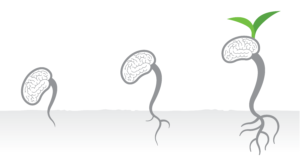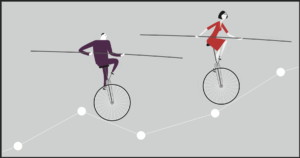The richest part of life lies in the space between absence and presence.
Pico Iyer, Essayist and novelist known for his travel writing.
Leadership Quote: The Unintended Consequences of Doing Nothing

Sometimes, the best thing to do is to go with the flow and let things play out. Sometimes, the best thing to do is to choose a desired outcome and lead others toward that outcome.
How do you decide?
I had a conversation this past week with a friend who was a banker earlier in his career. I asked him what he thought about the announcement earlier that day of the JP Morgan settlement regarding Jeffrey Epstein.
My initial thought was if a borrower is paying their loan on a timely basis, is the bank obligated to probe what the borrower is doing with the money?
My friend pointed out that if the bank is a relationship bank, the bankers meet with the client regularly and ask questions about the business. Turns out, internal emails revealed that executives did know about Epstein’s activities.
So why didn’t these executives, at least one of whom was a woman, speak up?
The conversation became uncomfortable when I asked this question, and we moved on to another topic.
While our conversation moved on, I’ve continued to wonder about my question:
- Is it because they felt the personal risk to themselves and their career was too great to speak up or take action?
- Is it because they somehow were able to compartmentalize and separate the business relationship from the question of “What if these were my daughters?”
- Is it because they didn’t believe what they heard?
- Is it because they feared Epstein could damage the bank’s reputation because he was so well connected?
- Is it because they feared legal repercussions as individuals or as an institution?
I wonder, too, if the executives involved paused and asked themselves these questions.
Perhaps not. Perhaps they were just going with the flow.
The Under-Rated Value of Patience

Patience is not one of my strong suits, so I looked up the definition before writing this story.
“the capacity to accept or tolerate delay, trouble, or suffering without getting angry or upset”
As leaders, most of us are action-oriented. Something crosses our desk; we deal with it. If an issue arises with a customer, a vendor, or an employee, we take action. Same with our health. We have an injury or an illness, and we immediately ask, what can I do to “fix” this? How can I expedite the healing?
And, sometimes, if we let things unfold at their own pace, we achieve a better result.
What?? Isn’t that avoidance or procrastination, or even laziness? And…
- Sometimes, that annoying email doesn’t require a response.
- Sometimes, working to “fix” an ache or pain or a situation causes a new one to “fix” someplace else.
- Sometimes action is needed, and sometimes doing nothing is simply the best strategy.
“Grant me the serenity to accept the things I cannot change, the courage to change the things I can, and the wisdom to know the difference.”
Blank Spaces Are As Important As Flowers

During our travels in Japan, we had the privilege of spending time with a Zen Priest. He talked to us about “the way” of Buddhist teachings, including the tea ceremony, ikebana, and calligraphy. Later on, we were fortunate to participate in a tea ceremony and ikebana, and it was through ikebana that I began to understand.
Ikebana is commonly thought of as the art of Japanese flower arranging, and as with most things in Japan, there is meaning beyond what you see.
In traditional Western flower arranging, the flowers face the viewer and are fitted tightly into the vase.
In the way of ikebana, our teacher told us, we place the flowers in the container in a way that resembles how they grow. And, most importantly, she said, “Remember the blank spaces are as important as the flowers.” She then showed us how our creations became three-dimensional when we added blank space.
The term ikebana comes from combining two words,
ikeru– life; and hana – flower.
My learning — ikebana is about using flowers to experience a life lesson: blank spaces in our words, deeds, and lives enhance and add dimension to our experience.
Leadership Quote: All the art of living…
All the art of living lies in a fine mingling of letting go and holding on.
Havelock Ellis, 19th Century English physician
The Secret of Life

I’ve had several conversations lately with clients and colleagues about life stages. In 1977, James Taylor wrote The Secret o’ Life. The full lyrics are worth a read, and here’s an excerpt:
The secret of life is enjoying the passage of time.
Any fool can do it,
There ain’t nothing to it.
Nobody knows how we got
To the top of the hill.
But since we’re on our way down,
We might as well enjoy the ride.
Isn’t it a lovely ride?
Sliding down, gliding down,
Try not to try too hard,
It’s just a lovely ride.
I am struck by Taylor’s wisdom at the age of 27 when he wrote this, and the lyrics remind me of a personal experience with an older man years later.
I was sitting on a bench at the old Union Station. The man sat down next to me, and we engaged in conversation. I asked him where he was headed, and he replied with glee, “San Francisco!”
“Wow,” I said, “that is a long way to go on the train.” His reply: “There is as much fun in getting there as there is in being there.”
Taylor’s lyrics and the words of the man on the bench have stayed with me, and I often think of their words in these situations:
- When I am too focused on getting to the outcome
- When it’s time to pause
- When it’s time to remember to be in the moment
As I embark on a trip to Japan in May, I plan to practice the in-the-moment secret, beginning with a hiatus from Sunday Stories. I will publish my usual end-of-month quote next week, and I will see you in June
Nurture Your Butterflies

When was the last time you wasted time? When you were “wasting time,” did you feel joyful and creative, or — if you’re like me, did you feel even a tiny bit guilty for “being unproductive?”
How much better might it have been? How much more would you have enjoyed your time — how much more would you have gotten out of it — if you didn’t feel guilty about it or feel the need to explain it?
Here’s a fact: downtime is vital to our lives.
As human beings, we often find ourselves caught in the never-ending cycle of productivity, constantly striving to achieve more.
Contrary to popular belief, wasting time can actually be beneficial for our overall well-being. However, wasting time poorly is a sin (or whichever word you prefer) because not only are you forgoing the productivity, generosity, and art that comes from work, but you’re also giving up the experimentation, creativity, and joy that comes from wasting time.
If you’re going to waste time (and I hope you will), please do it well; and find inspiration by nurturing your butterflies within.
What Is Your Story?

As human beings, we are all storytellers. Our lives are filled with experiences, memories, and emotions that shape our unique narratives.
Each of us has a story to tell, and the story about who we are today may differ from the story we want to write about tomorrow.
Reflecting on our past and present stories is an act of self-awareness that enables us to write our story of tomorrow. It’s about understanding the patterns, themes, and lessons that have emerged from our lives. It’s about recognizing the choices we’ve made, the challenges we’ve faced, and the growth we’ve experienced.
The good news is that we have the power to shape our stories, and we can rewrite the narratives and create new ones that align with our true selves.
Here are some suggestions to help you explore and understand your story:
- Reflect on your past: Take the time to reflect on your past experiences, both positive and negative. What have been the defining moments in your life? What lessons have you learned? How have these experiences shaped your beliefs and values?
- Identify your beliefs and values: What do you believe about yourself, others, and the world? What values are important to you? Knowing your beliefs and values can help you understand how you view the world and make decisions.
- Recognize your strengths and weaknesses: What are your strengths and weaknesses? What are you proud of? What do you want to improve? Understanding your strengths and weaknesses can help you make choices that align with your abilities and aspirations.
- Embrace your uniqueness: What makes you unique? What are your passions, interests, and talents? Embrace your individuality and celebrate what sets you apart from others. Your uniqueness is what makes it your story.
- Write your narrative: Once you have gained clarity on your today story, you can create a tomorrow story that aligns with your authentic self. Set new goals, take calculated risks, and pursue a path that resonates with your heart.
So, ask yourself: What is your story? And take the first step towards shaping a story that truly reflects who you are and who you aspire to be.
The Privilege of Choice

I frequently ask my clients, What are you willing to give up to get what you want?
The ‘give up’ may be something we believe. It may be fear (of failing, being wrong), comfort with what we have or know, or it may be tangible, a cost associated with a choice.
When we are talking about giving up something to get what we want, the key questions are these:
- How much do I want the “something” I say I want?
- What am I willing to give up to get it?
We live in a world of abundant choices. From the clothes we wear to the career choices we make, we are constantly faced with decisions that shape our lives. While having choices can be a privilege, it can also be a source of fear and anxiety. The fear of making the wrong choice or FOMO can paralyze us and prevent us from taking action.
The fear of making the wrong choice is a common experience that can prevent us from taking risks and pursuing the change we desire. However, we also know that making mistakes and experiencing setbacks is a natural part of growth and learning.
Here are some strategies for navigating the privilege and fear of choice:
- Consider what REALLY matters to you: Take the time to reflect on your values, passions, and goals. When you are clear on what matters, you can make choices that align with your authentic self.
- Prioritize and simplify: While having choices can be empowering, it can also lead to decision fatigue. To avoid this, prioritize your options and simplify your decision-making process. Consider what’s most important to you, and focus on the choices that align with your priorities.
- Take action: Making a choice involves taking a risk, but that doesn’t mean you have to be reckless. Instead, just as you do in business, gather information, weigh your options, consider the potential outcomes, and then take action.
In summary, having choices can be both a privilege and a source of fear. By cultivating self-awareness, prioritizing and simplifying, and taking calculated risks, we can effectively navigate the complex world of life choices.
Leadership Quote: Time Is Not Measured…
Time is not measured by the passing of years but by what one does, what one feels, and what one achieves.
Jawaharlal Nehru, First Prime Minister of India
 The initial results of my Pivot are excellent. I feel I have much greater clarity regarding the next 3-5 years..
The initial results of my Pivot are excellent. I feel I have much greater clarity regarding the next 3-5 years.. 